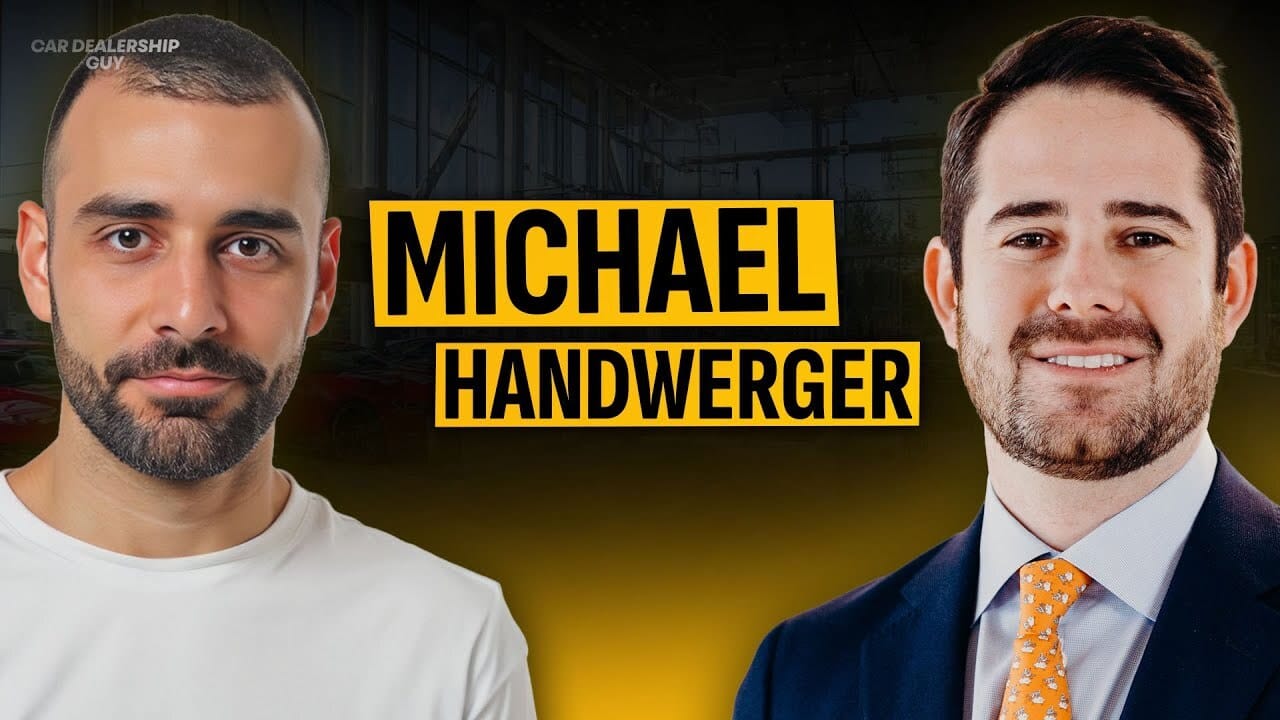
Welcome to another edition of the Car Dealership Guy Podcast Recap newsletter—the key lessons from top operators, founders, and execs shaping the future of auto retail.
Today’s guest is Michael Handwerger, President and Dealer Principal of Alpha One Automotive.
We break down his jump from a corporate career into dealership ownership, and why social media became one of his strongest tools for credibility and recruiting.


Building personal branding helps dealers build immediate trust.
Handwerger realized that credibility matters before people walk through the door, primarily when recruiting talent or acquiring stores in new markets.
“I’ve absolutely neglected social media… I started to begin to see advantages to it from relevancy, trust… especially when I’m trying to acquire talent.”
Now he’s posting consistently to show who he is and what his stores stand for.

Low-population markets eliminate walk-in traffic.
Rural stores with populations around 4,000–5,000, mean Handwerger can’t rely on high traffic, natural demand, or steady drive-ins from nearby cities. Every sale requires intentional outreach.
“Our stores are 4,000 people, 5,000 people… This is country roads… and that’s not really happening anymore.”
Every sale requires intentional outreach and hyper-local strategy.

Changes at rural dealerships can trigger backlash
Handwerger learned quickly that letting go of long-tenured employees, no matter the reason, can trigger community backlash, misinformation, and sudden sales drops.
“You have someone stand up in church and talk about how we’re terrible people… and everybody believes it.”
In rural markets, reputation spreads quickly, and consequences are immediate.

Matching staff and marketing to community demographics unlocked new buyers.
Handwerger’s stores weren’t initially aligned with the area’s heavily Hispanic market, but after adding Spanish-speaking staff and advertising, they began attracting first-time customers.
“We were not focusing on that at all… we didn’t have Spanish speakers on the showroom floor… those things have been really a focus for us.”
Aligning operations with local demographics opened entirely new customer segments.
Presented by:
1. Foureyes - Foureyes fixes what’s underneath —by connecting CRM, inventory, website, and DMS data so it’s clean, connected, and flowing. Then all the stuff you've been stacking on top? It finally works. Collect, connect, and put your data to work – visit @ foureyes.io to learn more
2. AFSA - Get Revv’d Up for the Ultimate Vehicle Finance Event of 2026 February 3rd to 5th, 2026 | Bellagio Hotel, Las Vegas, Nevada. The vehicle finance industry is evolving at breakneck speed. Are you ready to accelerate ahead of the competition? Join hundreds of industry leaders, innovators, and decision-makers at the 2026 American Financial Services Association Vehicle Finance Conference & Expo—the must-attend event where cutting-edge insights, powerful connections, and game-changing strategies converge under one roof. World-Class Keynote speakers who inspire action, and sessions that put vehicle finance insights into overdrive. Secure your spot today @ vf-conference.afsaonline.org - The 2026 AFSA Vehicle Finance Conference & Expo – Where the Leaders in Vehicle Finance Accelerate to Success.
3. CDG Circles - A modern peer group for auto dealers. Private dealer chats. Real insights — confidential, compliant, no travel required. Visit @ cdgcircles.com to learn more.

Digital service adoption increases behavior shifts.
Digital Multi-Point Inspections and video walkarounds are standard in metro stores, but Handwerger encountered consistent pushback from technicians and advisors unfamiliar with the technology.
“It’s now…better because we’ve….changed a lot of people and they’re used to…metro stores. This is not new to them.
The barrier was getting buy-in from people who'd never used it.

Tech adoption in rural stores requires patient leadership.
Digital Multi-Point Inspections and video walkarounds are standard in many stores, but he discovered they’re not plug-and-play in rural markets. Technicians didn’t want to record videos, advisors were uncomfortable with the medium, and every rollout attempt hit friction.
““It’s now… better because we’ve… changed a lot of people and they’re used to these things. They’ve been in metro stores. This is not new to them.”
Only after staffing changes did the stores finally embrace modern service processes.

Fixed ops growth is what moved the needle.
While variable operations faced volume constraints, fixed ops offered clear growth potential. Handwerger added 15 technicians, created four additional bays within existing structures, and invested heavily in equipment.
“Service… (improvements can cost) a million dollars at one store, half a million at another… 15 techs we've added, four bays… and I'm not saying we built—we added on to our infrastructure. We just found corners and ways to clear things out so that we can put a stall there.”
In low-volume markets, fixed ops growth drives profitability when new car sales plateau.

Rural GMs must be hunters, not maintainers.
General managers’ great track records struggled when business wasn’t walking through the door.
“It takes a different skill set to excel when the phone’s not ringing… you have to grow that business and it’s not there. You have to go get it.”
In rural stores, you can’t rely on natural volume. You have to hunt, market, partner locally, and build traffic from scratch.

Rural acquisitions now require a sharper strategy.
Higher prices and stricter lending are reshaping the landscape, so investing in people first ensures the next acquisition is the right one.
“We want to grow the right way with the right opportunities. At the same time, building a bench of people (before) an acquisition (ensures) we've got people that we can deploy to those opportunities.”
Opportunities exist, but successful expansion requires disciplined planning and a ready talent pool.

Aspiring dealers need honest insight before buying their first store.
Handwerger suggests future operators fully investigate the cultural, financial, and operational realities of rural acquisitions before they sign on the dotted line.
“If I knew some of these things going into our acquisitions, there probably would have been some different decisions made.”
His mission now is to help first-generation and small-market operators avoid painful surprises.













